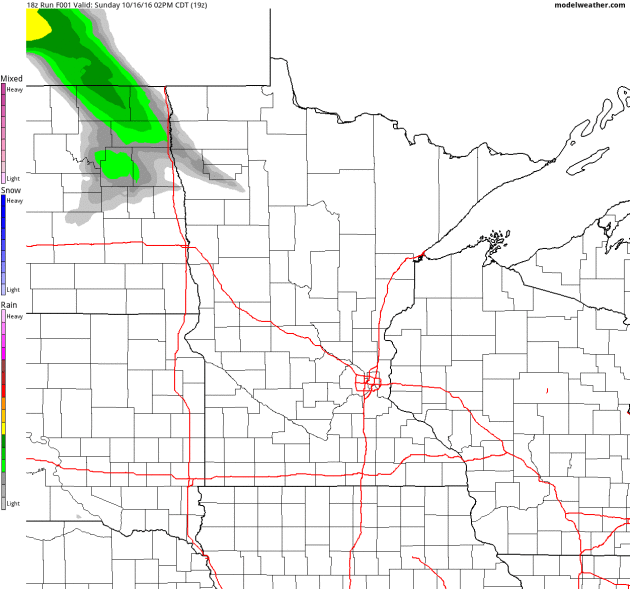68 F. high in the Twin Cities Sunday. Rochester hit a high of 72 F.
58 F. average high on October 16.
48 F. high on October 16, 2015.
October 17, 1971: Heavy rain falls in NW Minnesota. 4.02 inches is recorded at Georgetown (20 miles N of Moorhead).
October 17, 1952: Record lows between 10 to 15 degrees are reported across central Minnesota, including a low of 10 at St. Cloud, 12 at Glenwood, and 14 at Alexandria, Litchfield, and Mora.
Limping Into Autumn – No Weather Drama Brewing
The questions are benign, the weather almost an afterthought. “When will fall color peak?” “What time will the showers arrive?” “Is this next cool front jacket-worthy?”
Mother Nature is blowing us all a kiss, compared to Octobers gone by. On this date in 1880 western Minnesota was digging out from a severe blizzard that temporarily shut down the railroads. On October 17, 1952 St. Cloud awoke to 10 degrees.
You know, back when it actually snowed in October.
Yesterday was a fine spring day; my neighbor mowing a supernaturally-green lawn. No official frost yet, but mosquitoes are living on borrowed time.
A nearby frontal boundary ignites a few T-showers today as temperatures approach 70F in the MSP metro. We cool back down into the 50s by late week, but no obnoxiously cold air is on tap anytime soon.
The pattern doesn’t favor big, burly, full-latitude storms capable of high winds, heavy rain or snow. A “zonal”, west to east flow aloft should mean rapid changes and light rain showers.
The lowest mile of the atmosphere will be too warm for snow through at least Halloween.
What October? Check out predicted highs Monday afternoon: 90s to near 100F across Texas and Oklahoma into southwestern Kansas. With a sun angle as high in the sky as it was back in late February.

More Showers and T-storms Later Today. 4km NAM guidance from NOAA brings the best chance of showers and embedded T-storms into the area by late afternoon and evening; periods of heavy rain spilling into tonight before a west wind dries us out on Tuesday. Future Radar: NOAA and AerisWeather.
Late Week Cooling Trend. Nothing shriek-worthy shaping up yet – no need to rush out for milk and bread, but more typical weather for the latter half of October is on the way by Thursday. EMCWF data: WeatherBell.
Low Confidence for Halloween. A couple days ago NOAA’s GFS was carving out a deep, cold and stormy trough of low pressure across the Plains and Midwest. The latest solution hints at a relatively mild, dry, zonal flow; which would translate into 50s for Halloween. Odds are it won’t snow, but stay tuned, in case the models flip-flop again.
North Carolina Buildings Take $1.5 Billion Hit From Matthew Floods. Here’s an excerpt from AP: “Flooding spawned by Hurricane Matthew has caused $1.5 billion in damage to 100,000 homes, businesses and government buildings in North Carolina, according to a state estimate. The figure released late Saturday represents one of the first detailed analyses of damage from the storm, and it’s part of a growing picture of Matthew’s financial impact. With floodwaters yet to recede in some communities, officials say the number could fluctuate. “I do think that there may be more out there,” John Dorman, an assistant state emergency management director, said of whether the number could grow…”
Image credit: Capital Weather Gang, which has more astonishing, heartbreaking imagery from the thousand-year flood that hit North Carolina.
Hurricane Matthew Brought 1,000 Year Record Rainstorms to North Carolina. This would be the 6th thousand-year flood to strike the USA since October of 2015 (Texas, South Carolina, West Virginia, Maryland, Louisiana – now North Carolina). Here’s an excerpt from Pacific Standard: “The storm swept in by Hurricane Matthew has produced rainfall that exceeds the level expected about once every 1,000 years, according to a statistical analysis using National Oceanic and Atmospheric Administration data. Matthew broke numerous rainfall records in some of North Carolina’s toughest-hit towns, marking another spike in this year’s extreme weather. The new rainfall records were enabled by warming in the ocean and coastal atmospheres, which hold more water as temperatures increase — with a few cities across the Southeast reporting record levels of air moisture during the storm…” (October 6 file image: NOAA and AerisWeather).
Vietnam Floods: Deaths Reported, Tens of Thousands of Homes Destroyed. The Guardian has more information: “At least 11 people have died and several more are missing in heavy flooding in central Vietnam, state media said on Saturday, with tens of thousands of homes completely submerged by water. The communist government has ordered local authorities to mobilise the army and police to rescue trapped residents following heavy downpours, state-run Vietnam television reported. The channel said at least 11 had died in the flooding with some 27,000 homes under water in the region…”
Photo credit: “Floods surround houses in Vietnam’s Ha Tinh province after torrential rain submerged tens of thousands of houses.” Photograph: STR/EPA.
128 Homes Damaged, No One Injured: Manzanita (Oregon) Grateful, But Long Clean-Up Ahead. It’s strange to be tracking significant damage from a large tornado along the coastline of Oregon. OregonLive.com has more details: “School-aged children would usually be waiting on Laneda Avenue in the early morning light on a Thursday. But the street that leads from the Highway 101 to the ocean was quiet at 8:30 a.m. Thursday because of a teacher in-service day. Days later, even after the reality that no one was hurt or killed by a tornado that formed over the ocean and ripped into Manzanita, the possibility of what could have been gives Linda Kozlowski goosebumps. The tornado ripped up about one-third of the city’s trees and damaged 128 of its 600 homes. Five are irreparably harmed…”

Minnesota’s Warm, Wet Bias Continues. Here’s an interesting nugget from Dr. Mark Seeley’s always-informative weekly WeatherTalk update: “…Indeed, 6 of the 9 months so far this year have been significantly warmer than normal in Minnesota, two months were slightly warmer than normal, and only April of this year was cooler than normal on a statewide basis. The last significantly cooler than normal run of temperatures in Minnesota of 3 months duration or longer was from November of 2013 to April of 2014, a run of 6 consecutive months. Since 1996 only three years in Minnesota have been cooler than normal when averaging all 12 months. Those were 2008, 2013 and 2014…”
La Nina Watch. The on-again, off-again La Nina Watch is on again, according to NOAA CPC, calling for a cooling of Pacific Ocean water into the winter months. Will this result in a colder, harsher winter for North America? It’s still too early to tell, but the way the trends are going I wouldn’t bet on it.
Photo credit: Glen Stubbe, Star Tribune file. “Power generation at Sherco in 2012.”
Why Most People Will Never Be Successful. Way to pop my balloon. Here’s an excerpt from Inc: “Success” isn’t just having lots of money. Many people with lots of money have horribly unhappy and radically imbalanced lives. Success is continuously improving who you are, how you live, how you serve, and how you relate. So why won’t most people be successful? Why don’t most people evolve? The more evolved you become, the more focused you must be on those few things which matter most. Yet, as Jim Rohn has said, “A lot of people don’t do well simply because they major in minor things…”
NFL Ratings Plunge Could Spell Doom for Traditional TV. Because we’re increasingly addicted to our smart phones, according to The Washington Post: “…Network executives have long used the National Football League’s live games as a last line of defense against the rapid growth of “cord-cutting” and on-demand viewing upending the industry. But now, the NFL is seeing its ratings tumble in the same way that the Olympics, awards shows and other live events have, falling more than 10 percent for the first five weeks of the season compared with the first five weeks of last season. A continued slide, executives say, could pose an even bigger danger: If football can’t survive the new age of TV, what can?…”
Photo credit: “New England Patriots quarterback Tom Brady fakes a hand off during an NFL football game against the Cleveland Browns, Sunday, Oct. 9, 2016, in Cleveland. New England won 33-13.” (David Richard/AP).

TODAY: Lot’s of clouds, few showers & T-showers, mild. Winds: NE 5-10. High: near 70
MONDAY NIGHT: Showers taper, cooling down. Low: 52
TUESDAY: Partly sunny and drier. Winds: W 8-13. High: 64
WEDNESDAY: Mix of clouds and sun, seasonable. Winds: NW 8-13. Wake-up: 46. High: 59
THURSDAY: Partly sunny, oddly October-like. Winds: NW 8-13. Wake-up: 42. High: 53
FRIDAY: Clouds increase, few showers up north. Winds: SE 10-15. Wake-up: 36. High: 57
SATURDAY: Intervals of sun, not bad at all. Winds: W 7-12. Wake-up: 44. High: 60
SUNDAY: Early shower, then slow clearing. Winds: N 5-10. Wake-up: 47. High: 55
Climate Stories….
Scientists Warn Negative Emissions Are a “Moral Hazard”. Will we ever be able to (cost-effectively) suck CO2 out of the air to slow the global warming trend? Perhaps – but can we count on it? Here’s an excerpt from Climate Central: “Removing carbon dioxide emissions from the atmosphere to prevent global warming from becoming catastrophic may be a fool’s game amounting to a “moral hazard par excellence,” according to a paper published Thursday in the journal Science. Nobody knows if atmospheric carbon removal — known as negative emissions — will work, and it could delay critical cuts to emissions while tacitly giving people license to pollute, the paper says…” (File image: NASA).
Photo credit: “Michaela Sumpter and Cameron Wiltz, 3, evacuate the Forestwood Apartments in the Olde Towne area after Hurricane Isaac passed through Slidell, Louisiana, August 30, 2012.” Credit: Michael Spooneybarger/Reuters.

